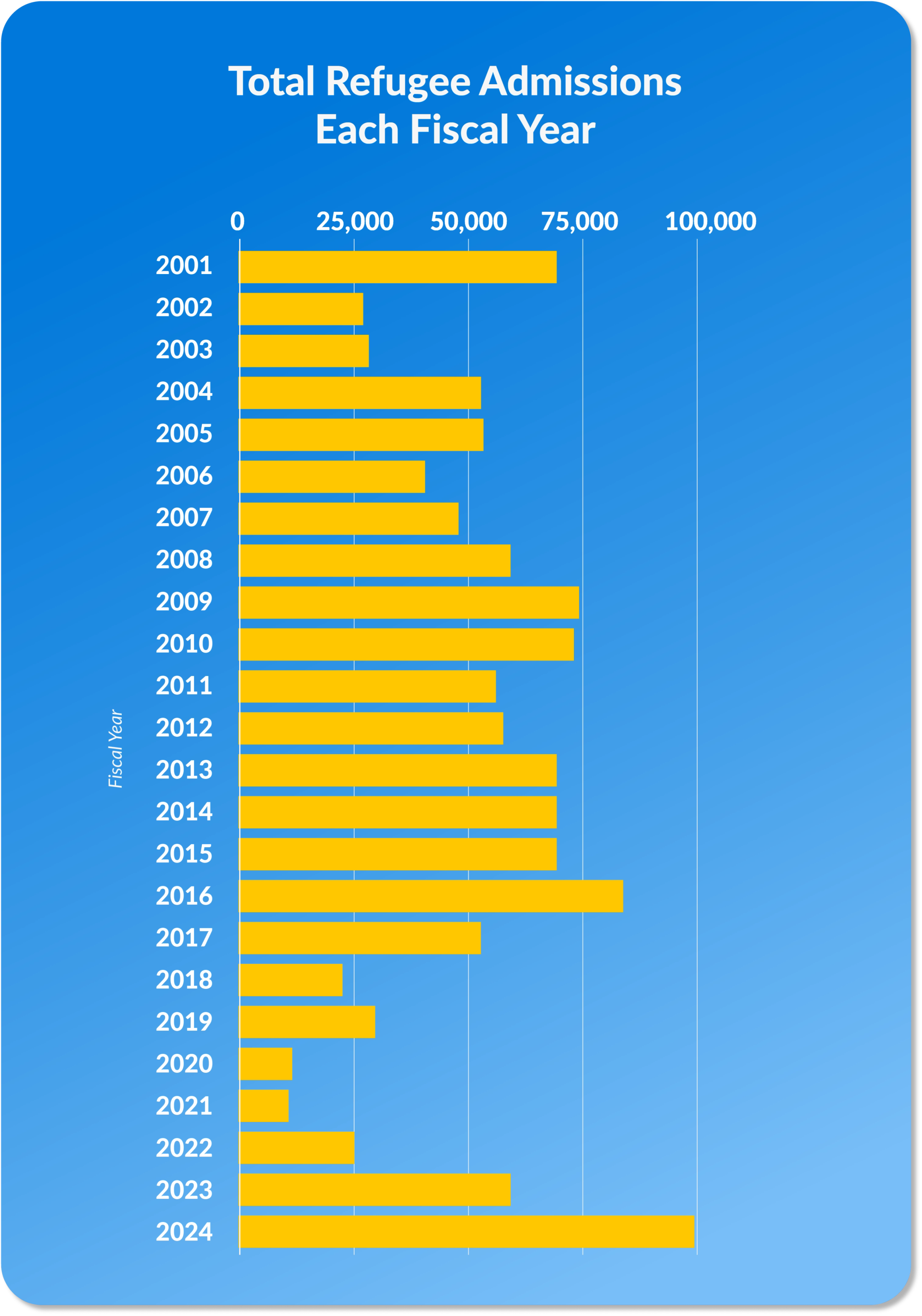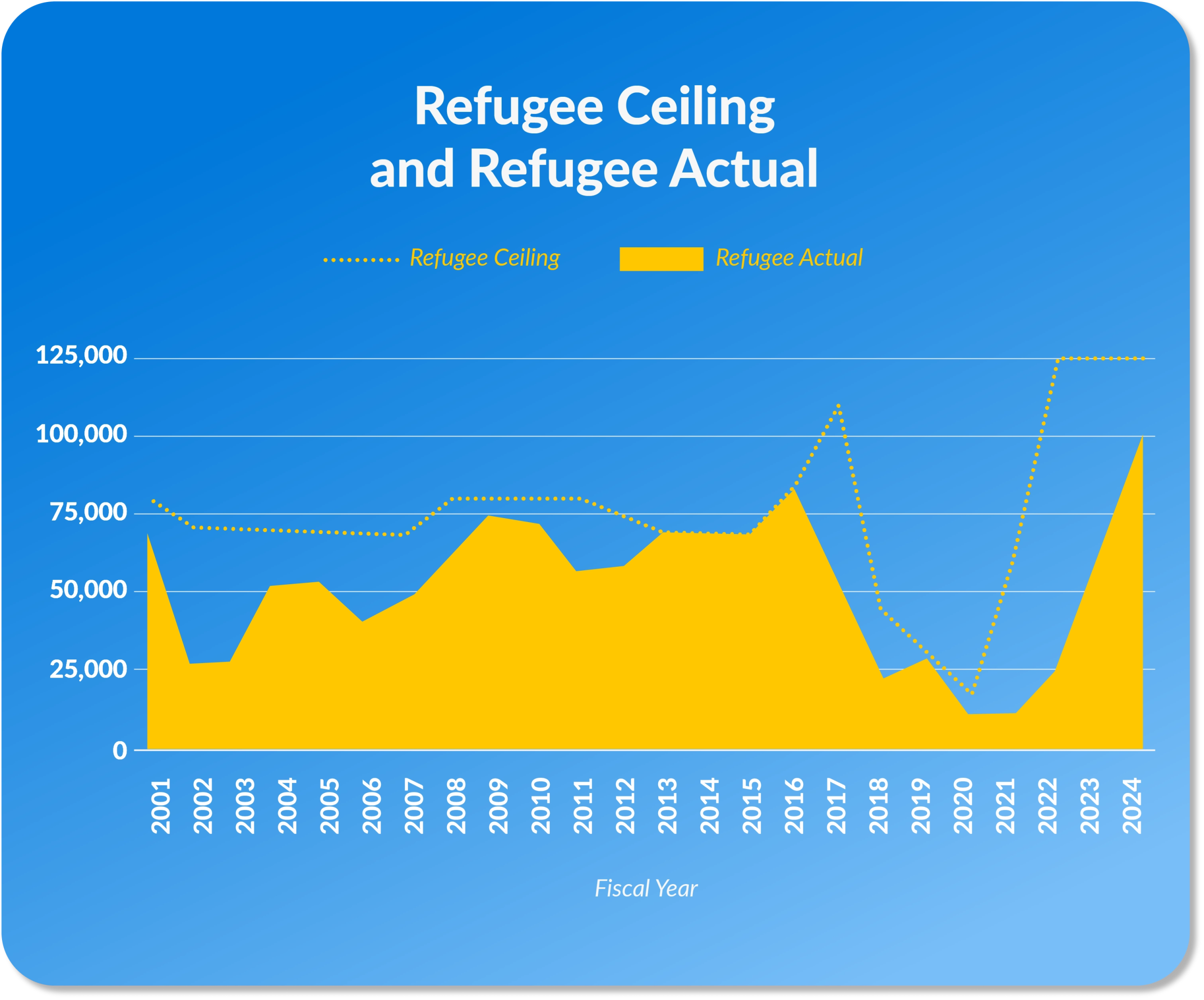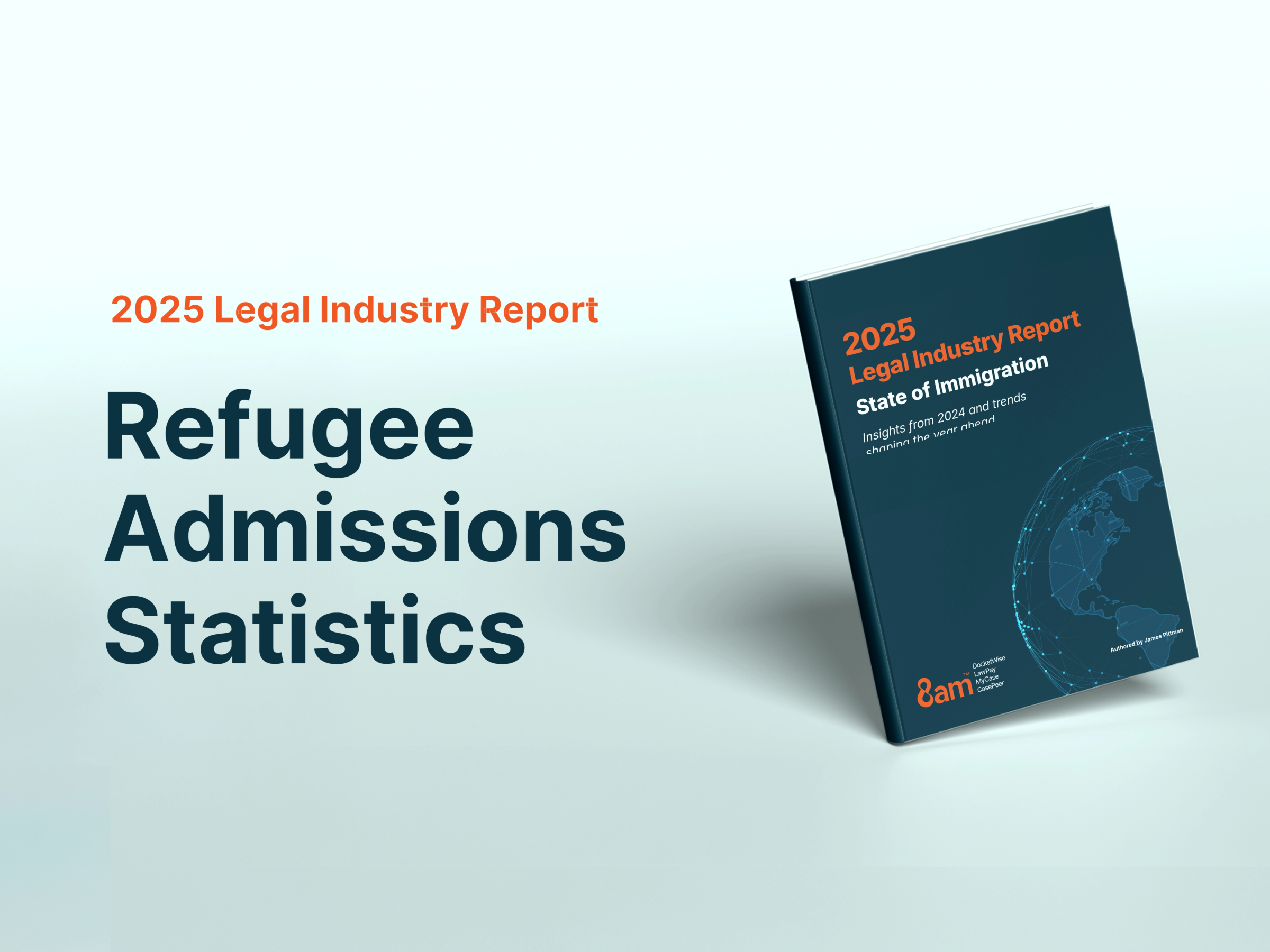The United States admitted 100,034 refugees during fiscal year 2024, marking one of the strongest years for U.S. refugee resettlement in recent history. However, that trend is on course to reverse sharply in 2025, as recent federal government actions have put refugee admissions on hold indefinitely.
This shift comes at a time when global refugee displacements are approaching record highs. According to the United Nations refugee agency, UNHCR, there were 42.7 million refugees worldwide at the end of 2024. While this figure represents a slight decrease from the previous year, the number of refugees protected under UNHCR’s mandate has more than doubled over the past decade.
For immigration attorneys, these statistics provide important context for legal practice. A clear understanding of global and domestic trends can help lawyers anticipate client needs, manage resources effectively, and adapt strategies in a rapidly changing policy environment.
In this article, we’ll discuss current and historical trends to provide a clearer view of U.S. refugee resettlement and examine what the latest developments mean for immigration law practices.
How many refugees are accepted into the U.S. every year?
A refugee, as defined by the UN, is someone who is forced to flee their home country and is unable to return due to fears of persecution based on race, religion, nationality, membership in a particular social group, or political beliefs.
There are two key figures to consider when reviewing refugee admissions trends: the annual ceiling, which is set by the President in consultation with Congress, and the actual number of individuals resettled through the U.S. Refugee Admissions Program (USRAP).
So how many refugees does the U.S. take each year? In fiscal year 2024, 100,034 refugees were admitted into the U.S., while the annual ceiling was set at 125,000 admissions. While short of the limit, this amounts to the most refugee admissions since 1994, according to the Office of Homeland Security Statistics.

Refugee ceiling vs. actual admissions by year
There have been some dramatic swings in refugee admissions over the past decade, with significant gaps between the ceiling and how many refugees enter the U.S. each year.
2015: Ceiling 70,000 | Actual 69,933
2016: Ceiling 85,000 | Actual 84,994
2017: Ceiling 110,000 | Actual 53,716
2018: Ceiling 45,000 | Actual 22,491
2019: Ceiling 30,000 | Actual 30,000
2020: Ceiling 18,000 | Actual 11,814
2021: Ceiling 62,500 | Actual 11,411
2022: Ceiling 125,000 | Actual 25,465
2023: Ceiling 125,000 | Actual 60,014
2024: Ceiling 125,000 | Actual 100,034
There are a number of factors that cause refugee admissions to routinely fall short of annual ceilings, including extended processing backlogs, heightened security vetting requirements, changes to eligibility criteria, and shifting political priorities. Funding cuts to public resettlement agencies and nongovernmental organizations can also impact admissions by diminishing resources needed to receive and support refugees.
Broader global challenges also affect immigration trends. For example, the COVID-19 pandemic caused a steep decline in refugee admissions from 2020 through 2022, as international travel restrictions and health protocols created major barriers to resettlement.

Refugee admissions by region
In 2024, U.S. refugee resettlements reflected the broad reach of global displacement. Here is a breakdown of admissions by region:
Africa: 34,017
Near East/South Asia: 29,939
Latin America/Caribbean: 25,358
East Asia: 7,540
Europe and Central Asia: 3,180
Regional refugee statistics are largely influenced by ongoing humanitarian crises. Africa and the Near East/South Asia consistently account for the largest shares of the refugee population, driven by protracted conflicts, political repression, and fragile governance.
Economic collapse and gang violence have contributed to displacement of refugees from Latin America and the Caribbean, while political instability and war have fueled refugee migrations from East Asia, Central Asia, and Europe.
For immigration lawyers, monitoring these regional shifts can provide early insight into the languages, cultural backgrounds, and legal circumstances of prospective clients. This awareness can guide firms as they budget resources for interpreters, community outreach, and services to address the distinct needs of refugee populations arriving from different parts of the world.
Which countries do most refugees come from to the U.S.?
While regional trends provide a high-level view of global displacement, examining refugee admissions by country reveals deeper insights into the factors shaping immigration patterns. The following is a list of the 10 countries with the highest number of refugee admissions to the U.S. in 2024.
1) Democratic Republic of Congo – 19,923
Armed conflict and ongoing violence continue to displace millions of people from the DRC, making it one of the most consistent sources of U.S.-bound refugees.
2) Afghanistan – 14,708
Decades of war, intensified by the Taliban’s return to power in 2021, remain a major factor driving resettlement needs.
3) Venezuela – 12,875
A prolonged political and economic crisis has led to a major increase in refugee admissions from Venezuela in recent years.
4) Syria – 11,274
Syria’s civil war, now in its second decade, continues to drive millions of people from their homes.
5) Burma (Myanmar) – 6,459
Myanmar’s 2021 military coup and widespread human rights abuses have fueled a surge in refugee departures.
6) Ukraine – 5,809
Russia’s 2022 invasion of Ukraine has displaced millions of refugees, many of whom have sought protection in the U.S. and Europe.
7) Eritrea – 5,216
An authoritarian government, forced military conscription, and repression of civil liberties have pushed many refugees to flee from Eritrea.
8) El Salvador – 4,996
Organized crime, gang violence, and political instability continue to drive displacement from El Salvador.
9) Iraq – 4,207
Despite years of international intervention, violent conflict and ongoing political instability continue to force many Iraqis to seek refuge abroad.
10) Guatemala – 4,186
Persistent poverty, widespread corruption, and high levels of violence have fueled migration from Guatemala.
Immigration attorneys who stay current on refugee resettlement statistics from specific nations can prepare in advance to file relevant documentation, provide trauma-sensitive support, and build strong arguments for clients in refugee and asylum cases.
How Trump-era policies are impacting U.S. refugee resettlement statistics
The U.S. admitted 27,308 refugees through the U.S. Refugee Admissions Program (USRAP) in the first quarter of fiscal year 2025 (October 1 to December 31, 2024). However, resettlements came to an abrupt halt in January 2025, when President Donald Trump issued an executive order suspending USRAP indefinitely. As of August 2025, all refugee processing, travel, and admissions remain blocked.
Trump’s refugee resettlement suspension
Trump’s executive order, titled “Realigning the United States Refugee Admissions Program,” suspended both processing of new refugee applications and refugee arrivals until further notice, granting resettlements only on a narrow, case‐by‐case basis. It also called for reviews every 90 days to reassess whether resuming the program aligns with U.S. interests. In practical terms, this means even refugees who had been fully vetted and scheduled for travel have had their resettlements canceled without clear next steps.
Disruption, backlash, and legal pushback
The executive order also slashed funding for nonprofit resettlement organizations that provide support and services to refugees in America. Many of these nonprofits have had to cease operations and lay off staff as a result of the USRAP suspension and funding cuts.
Several legal challenges have unfolded since Trump signed the order. In February 2025, a federal judge in Seattle issued a preliminary injunction blocking the suspension, stating the president’s authority has clear limits and cannot override Congress’ established framework for refugee admissions. An appeals court partially narrowed that ruling, allowing refugees who had already been conditionally approved to enter—while continuing to block new admissions. Meanwhile, cases like Pacito v. Trump have challenged the legality of the indefinite ban.
Legal and humanitarian implications
Such abrupt shifts pose serious challenges for immigration attorneys and their clients. Cases that have been in progress for months or even years may now be stalled indefinitely. The uncertainty makes it difficult for lawyers to offer clients reliable guidance on timelines or potential outcomes.
To provide the best service possible under these circumstances, attorneys must stay alert to new policy developments and court decisions. Alternative pathways, such as direct asylum filings or humanitarian parole, may offer options for refugees in the meantime.
Strategic practice management considerations for immigration lawyers
For immigration lawyers, refugee admissions statistics provide early insight into the populations that are most likely to seek legal support and the types of cases that may surface in the months ahead. By monitoring these trends, attorneys can make more informed decisions about how to allocate resources, engage potential clients, and develop legal strategy.
Below are examples of how immigration firms can translate resettlement data into practical actions that enable them to serve refugee clients effectively.
Geographic demand forecasting
Reviewing refugee admissions data by state or metro area can help identify areas where resettled populations are likely to grow. For example, in 2024, large numbers of Congolese refugees were resettled in Texas, Kentucky, and Ohio, while Afghan arrivals were highest in California, Texas, and Virginia. Understanding these patterns can help law firms decide whether to expand services, open satellite offices, or strengthen referral networks in areas expecting high inflows of refugee clients.
Geographic analysis also informs cultural and language translation needs. For example, if data indicates rising numbers of refugee arrivals from Spanish-speaking countries, firms may prioritize hiring bilingual staff or partnering with community organizations that provide interpretation services for Spanish speakers. By aligning staffing and outreach with geographic settlement trends, immigration attorneys can be better prepared to meet the needs of their evolving client base.
Client segmentation by likely eligibility
Refugee admissions data also sheds light on how many individuals may soon qualify for status adjustments or other benefits. Refugees are generally eligible to apply for lawful permanent residency one year after arrival. Each new wave of admissions signals an incoming group of potential clients who may need assistance with these filings in the following year.
By tracking these cycles, firms can organize client lists and conduct proactive outreach. For example, attorneys can schedule follow-ups with clients who arrived the previous year, reminding them of their adjustment options and supporting timely filings. Grouping clients by arrival year or country of origin can further streamline communications and document preparation.
This type of planning not only helps clients avoid missing deadlines but also positions attorneys as trusted partners who will guide them through the process with foresight and care.
Training and staffing decisions
Refugee admissions statistics can also inform staffing and training plans. Anticipating future increases in filings such as adjustment of status applications, asylum petitions, and family reunification cases gives firms time to hire additional staff, offer specialized training in refugee law, or cross-train paralegals.
Monitoring backlog statistics is equally important. When new arrivals slow—whether due to policy changes or external factors—firms may need to shift focus. In these situations, staff can redirect attention toward other forms of relief such as humanitarian parole or Temporary Protected Status, which often see greater demand when refugee pathways narrow. Keeping a close eye on admissions data allows firms to adapt to these changes more quickly and maintain consistent support for clients even as policies shift.
Download the 2025 State of Immigration Report
Understanding refugee statistics is critical for immigration law firms seeking to provide reliable guidance, allocate resources effectively, and anticipate client needs. With immigration policies changing rapidly and global displacement near historic highs, access to quality data is essential for making informed decisions.
The 2025 State of Immigration Report from 8amTM DocketWise offers in-depth analysis of key trends for immigration lawyers, including data on naturalization, green cards, asylum cases, and immigration court statistics. This comprehensive resource provides attorneys with actionable, data-driven insights that support stronger case strategies and long-term practice planning.
Download the full report here.
Ready to see how DocketWise can help your firm put these insights into practice? Schedule a demo today.
About the author

Rob HeidrickContent Writer
Rob Heidrick is a Content Writer for 8am, a leading professional business solution. He covers the latest advancements in legal technology, financial wellness for law firms, and key industry trends.
